There is Sweet Music Here
-
Ships in 1 to 2 weeks
Details
Description
SKU: CF.CM9594
Composed by Greg Gilpin. Fold. Performance Score. 8 pages. Duration 2 minutes, 50 seconds. Carl Fischer Music #CM9594. Published by Carl Fischer Music (CF.CM9594).ISBN 9781491154168. UPC: 680160912667. 6.875 x 10.5 inches. Key: Bb major. English. Alfred Tennyson. Alfred, Lord Tennyson (1809-1892).
The text of Alfred, Lord Tennyson's There is Sweet Music Here is a wonderful example of word painting. Keep this in mind while learning to sing the music and try to capture the different scenes created through these famous words. The first two measures of accompaniment outline the opening chord in the voices. Crescendo to the word music every time it occurs. In mm. 710, the vocals cascade gently into a dissonance that develops into a full, rich sound. Allow the piano to support the unison lines in mm. 1417 as well as those that contain three-part singing. The piano establishes a consistent undulating tempo in mm. 2225, as if lulling someone to sleep. Be intentional with word/syllabic stress when singing through the quarter notes. Maintain a consistent tempo when singing the eighth notes in mm. 3336. The chord progression helps establish the coolness of the mosses and ivies. Notice the melodic movement in mm. 3738 reflecting the craggy ledge and hanging poppy followed by the unison sleep which ushers in the return of the original melody within the accompaniment. Linger with quiet, full and supported singing during the last three measures.
The text of Alfred, Lord Tennyson'sA There is Sweet Music HereA is a wonderful example of word painting. Keep this in mind while learning to sing the music and try to capture the different scenes created through these famous words. The first two measures of accompaniment outline the opening chord in the voices. Crescendo to the word music every time it occurs. In mm. 7a10, the vocals cascade gently into a dissonance that develops into a full, rich sound. Allow the piano to support the unison lines in mm. 14a17 as well as those that contain three-part singing. The piano establishes a consistent undulating tempo in mm. 22a25, as if lulling someone to sleep. Be intentional with word/syllabic stress when singing through the quarter notes. Maintain a consistent tempo when singing the eighth notes in mm. 33a36. The chord progression helps establish the coolness of the mosses and ivies. Notice the melodic movement in mm. 37a38 reflecting the craggy ledge and hanging poppy followed by the unison sleep which ushers in the return of the original melody within the accompaniment. Linger with quiet, full and supported singing during the last three measures.
The text of Alfred, Lord Tennyson'sA There is Sweet Music HereA is a wonderful example of word painting. Keep this in mind while learning to sing the music and try to capture the different scenes created through these famous words. The first two measures of accompaniment outline the opening chord in the voices. Crescendo to the word "music" every time it occurs. In mm. 7a10, the vocals cascade gently into a dissonance that develops into a full, rich sound. Allow the piano to support the unison lines in mm. 14a17 as well as those that contain three-part singing. The piano establishes a consistent undulating tempo in mm. 22a25, as if lulling someone to sleep. Be intentional with word/syllabic stress when singing through the quarter notes. Maintain a consistent tempo when singing the eighth notes in mm. 33a36. The chord progression helps establish the "coolness" of the mosses and ivies. Notice the melodic movement in mm. 37a38 reflecting the "craggy ledge and hanging poppy" followed by the unison "sleep" which ushers in the return of the original melody within the accompaniment. Linger with quiet, full and supported singing during the last three measures.
The text of Alfred, Lord Tennyson's There is Sweet Music Here is a wonderful example of word painting. Keep this in mind while learning to sing the music and try to capture the different scenes created through these famous words. The first two measures of accompaniment outline the opening chord in the voices. Crescendo to the word "music" every time it occurs. In mm. 7-10, the vocals cascade gently into a dissonance that develops into a full, rich sound. Allow the piano to support the unison lines in mm. 14-17 as well as those that contain three-part singing. The piano establishes a consistent undulating tempo in mm. 22-25, as if lulling someone to sleep. Be intentional with word/syllabic stress when singing through the quarter notes. Maintain a consistent tempo when singing the eighth notes in mm. 33-36. The chord progression helps establish the "coolness" of the mosses and ivies. Notice the melodic movement in mm. 37-38 reflecting the "craggy ledge and hanging poppy" followed by the unison "sleep" which ushers in the return of the original melody within the accompaniment. Linger with quiet, full and supported singing during the last three measures.
The text of Alfred, Lord Tennyson's There is Sweet Music Here is a wonderful example of word painting. Keep this in mind while learning to sing the music and try to capture the different scenes created through these famous words. The first two measures of accompaniment outline the opening chord in the voices. Crescendo to the word "music" every time it occurs. In mm. 7-10, the vocals cascade gently into a dissonance that develops into a full, rich sound. Allow the piano to support the unison lines in mm. 14-17 as well as those that contain three-part singing. The piano establishes a consistent undulating tempo in mm. 22-25, as if lulling someone to sleep. Be intentional with word/syllabic stress when singing through the quarter notes. Maintain a consistent tempo when singing the eighth notes in mm. 33-36. The chord progression helps establish the "coolness" of the mosses and ivies. Notice the melodic movement in mm. 37-38 reflecting the "craggy ledge and hanging poppy" followed by the unison "sleep" which ushers in the return of the original melody within the accompaniment. Linger with quiet, full and supported singing during the last three measures.
The text of Alfred, Lord Tennyson's There is Sweet Music Here is a wonderful example of word painting. Keep this in mind while learning to sing the music and try to capture the different scenes created through these famous words.The first two measures of accompaniment outline the opening chord in the voices. Crescendo to the word "music" every time it occurs. In mm. 7–10, the vocals cascade gently into a dissonance that develops into a full, rich sound. Allow the piano to support the unison lines in mm. 14–17 as well as those that contain three-part singing.The piano establishes a consistent undulating tempo in mm. 22–25, as if lulling someone to sleep. Be intentional with word/syllabic stress when singing through the quarter notes.Maintain a consistent tempo when singing the eighth notes in mm. 33–36. The chord progression helps establish the "coolness" of the mosses and ivies. Notice the melodic movement in mm. 37–38 reflecting the "craggy ledge and hanging poppy" followed by the unison "sleep" which ushers in the return of the original melody within the accompaniment.Linger with quiet, full and supported singing during the last three measures.
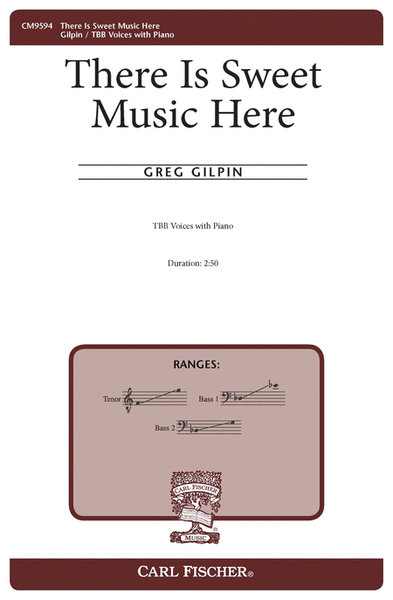
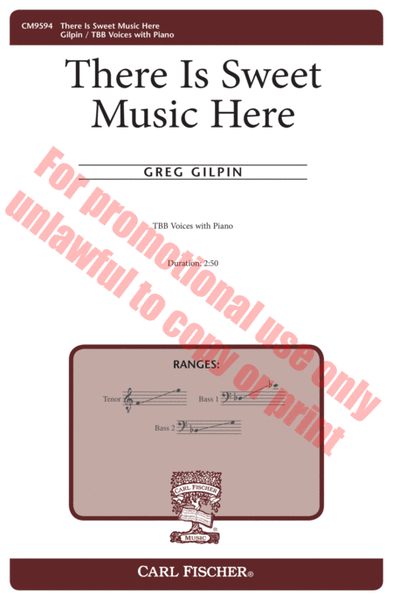
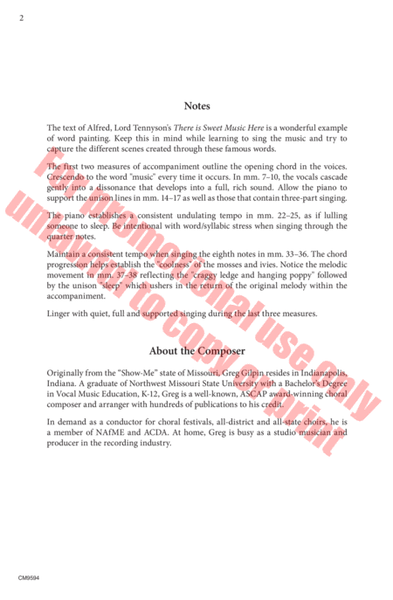
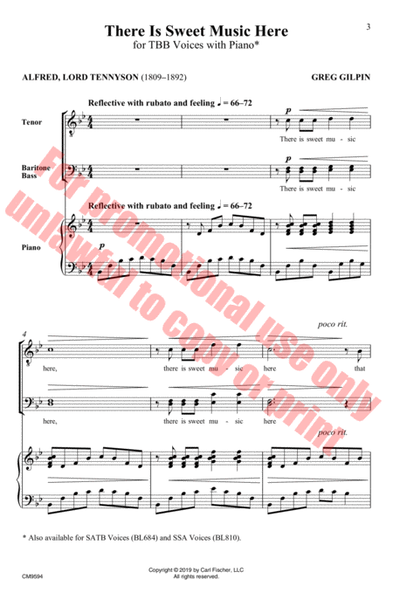
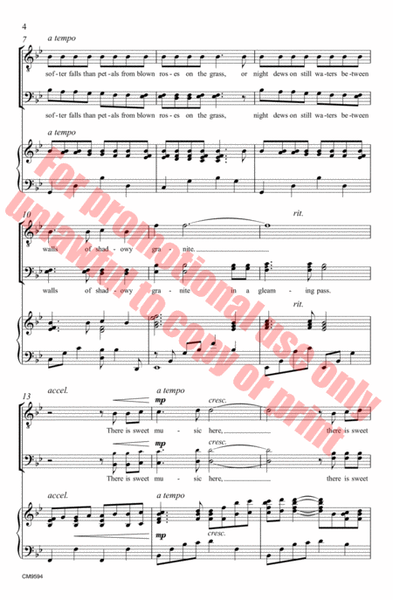

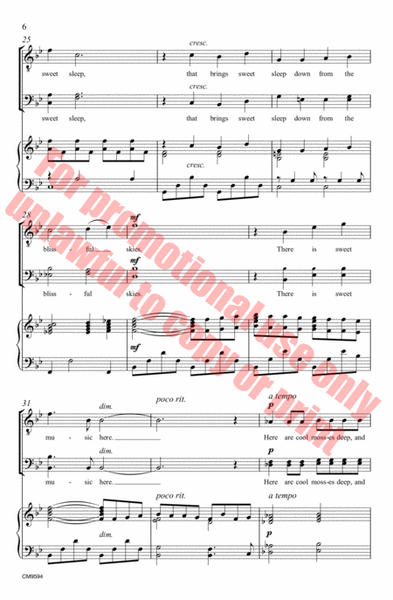
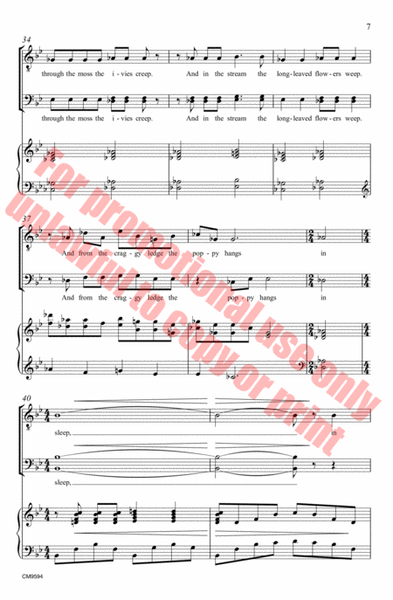
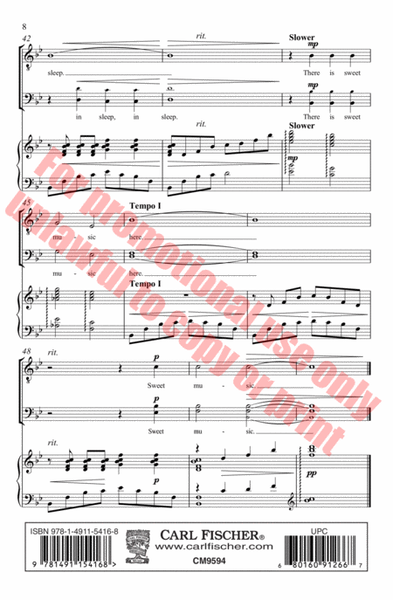
 Share
Share